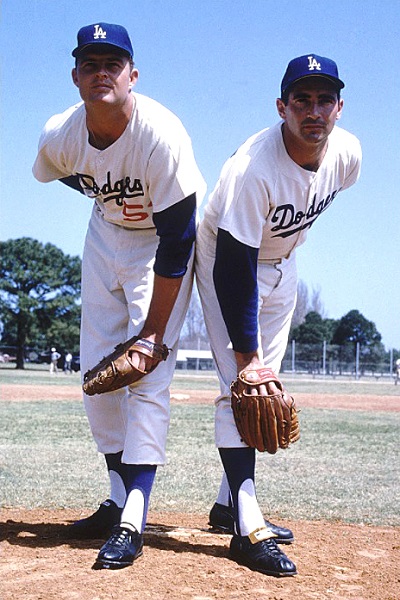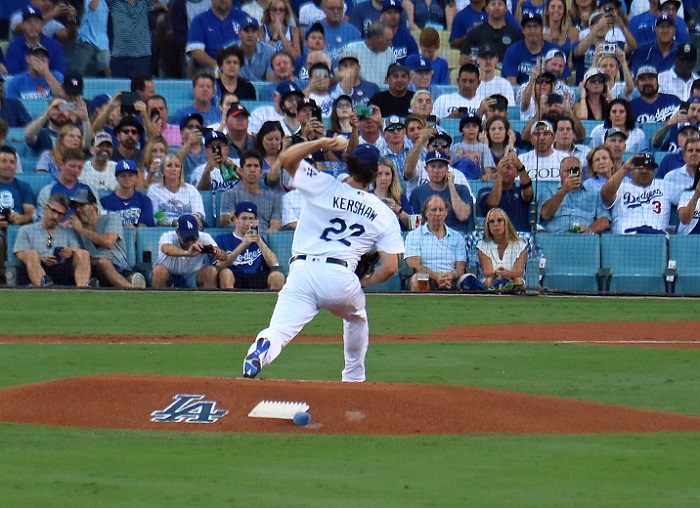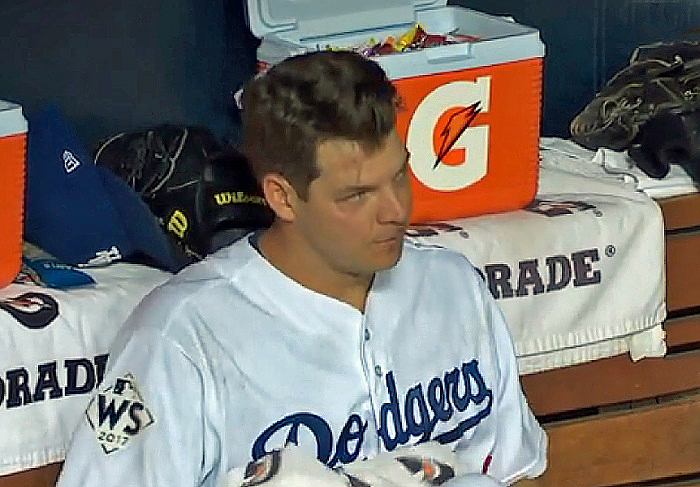In 1962, Dodgers Hall of Fame right-hander Don Drysdale won an MLB-best 25 games with only nine losses while posting a remarkable 2.83 earned run average. In doing so, he easily won the 1962 Cy Young award – back when there was only one given in all of baseball – and effectively punched his ticket to Cooperstown.
During that historic season, the Dodgers first in (then) brand new Dodger Stadium, Big-D struck out 232 opposing batters and walked 78. He also hit 11 batters, presumably most of them on purpose. In fact, he once hit Yankees slugger Mickey Mantle on the right shoulder and later told reporters that he asked the future Hall of Famer: “Do you want me to sign that bruise for you?” But hands down, the most remarkable accomplishment for Drysdale during that historic season was that of his MLB-leading 41 starts, he threw complete games in 19 of them in his 314.1 innings pitched.
One year later, in 1963, Dodgers Hall of Fame left-hander Sandy Koufax, whom many still consider the greatest lefty of all time, matched Drysdale’s 25 wins while losing only five games, prompting colorful Yankees Hall of Famer Yogi Berra to say: “I can see how he won 25 games. What I don’t understand is how he lost five.”
Koufax posted an absolutely insane 1.88 ERA that season and easily won the first of his three Cy Young awards. He was also named the 1963 National League MVP. But hands down, the most remarkable accomplishment for Koufax during that historic 1963 season was that of the his 40 starts, he threw complete games in 20 of them – 11 via shutout – in his MLB-leading 311.0 innings pitched.

Even to this day there has never been a more feared righty-lefty duo than Don Drysdale and Sandy Koufax. Between the two of them they made 779 starts and completed 304 of them. (AP photo)
Do you see a pattern here?
No, it’s not the combined four Cy Young awards that Koufax and Drysdale won, or their eventual enshrinement into the sacred Halls of Cooperstown. It’s the combined 39 complete games that two of the greatest pitchers to even play the game had in their combined 81 games started during the 1962 and 1963 seasons.
But even these numbers pale in comparison to their respective individual career numbers. Of his 465 career starts over his 14 MLB seasons, Drysdale completed 167 of them. That’s 35.9 percent of them. As for Koufax, of the 314 games that he started over his 12 MLB seasons, he completed 137 of them. That’s 43.6 percent of them. I mean, who does that anymore?
The answer is obvious. No one.
In fact, even future Hall of Famer Clayton Kershaw with his remarkable 144-64 career record and outstanding 2.36 career ERA over his 10 MLB seasons has completed only 25 of the 290 games that he has started. That’s only 8.6 percent of them, and even that is remarkably high in this day and age.

Through 10 major league seasons, Dodgers ace Clayton Kershaw has thrown 25 complete games in his 290 starts. But the way the game is evolving, he may not throw many more … if any. (Photo credit – Ron Cervenka)
So what happened? Why such a drastic change in the number of complete games by today’s starting pitchers?
The seemingly simple and perhaps even obvious answer is that teams today are trying to reduce the risk of injury to their (very) highly paid starting pitchers by reducing the number of innings that they pitch, thereby (hopefully) prolonging their respective careers. But the real answer, at least in today’s game, is the dreaded “A” word.
Analytics.
Sometime during this past season someone determined that having starting pitchers face opposing hitters a third time was the proverbial ‘kiss of death.’ As such, managers – probably under direct orders from above – began pulling their starters after going through the opposing team’s lineup twice. In other words, regardless of the score, especially in close games, starting pitchers were facing only 18 total batters.
As a result, not only are complete games becoming a thing of the past, so too are the coveted 20-win seasons that have been the goal of every starting pitcher throughout the 148-year history of the game. In fact, setting a limit of only twice through the lineup now puts even a 10-win season in jeopardy for no other reason than a starter would have to retire 15 of the 18 batters he faces to even reach the requisite five innings to earn a win. There is no greater example of this than game-2 of the recently concluded 2017 World Series.
Who can forget the look of sheer disgust on the face of Dodgers left-hander Rich Hill after being informed by Dodgers manager Dave Roberts that he would not be pitching the top half of the fifth inning because the Astros lineup was going to turn over for the third time, this in spite of the fact that the 37-year-old Boston, Massachusetts native had allowed only one run on three hits with three walks and seven strikeouts to the 18 batters he had faced through his 4.0 innings of work.
Granted, Hill was trailing by a score of 1-0 at the time, but he had made only 60 pitches to that point and, again, had struck out seven of the 18 batters he had faced. Even Clayton Kershaw has said on several occasions that getting out of an inning in 15 pitches or less is the goal of every starting pitcher, and Hill was at that exact number through his four inning of work.

There isn’t much doubt what Rich Hill thought about being pulled in game-2 of the World Series after having faced only 18 batters. (Video Capture courtesy of MLB.TV)
Sure enough, the Dodgers tied the game at 1-1 in the bottom half of the fifth inning on a Joc Pederson solo home run and took a 3-1 lead in the bottom of the sixth on a two-run blast by Corey Seager. Unfortunately, the Dodgers would eventually lose the game in 11 innings of what was arguably the most exciting World Series game played at Dodger Stadium since the Kirk Gibson home run game during the 1988 World Series.
Although there will always be elite Kershaw-like starting pitchers and there will certainly be exceptions to this ‘no-third-time-through-the-lineup’ thing, the simple truth is that teams today (and in the future) will more than likely make future draft picks geared towards building more efficient bullpens instead of building better starting rotations. As such, the insanely high salaries and contracts that starting pitchers are currently making will probably be diverted towards acquiring elite relievers. In fact, the trend has already started with the game’s best closers, like Yankees closer Aroldis Chapman‘s five-year / $86 million contract through 2021 and Dodgers closer Kenley Jansen‘s five-year / $80 million contract, also through 2021.
But while it is important – imperative even – for teams to have an elite closer, and lets face it, the Dodgers are blessed to have the very best in the game today, this ‘no-third-time-through-the-lineup’ analytics thing makes middle relievers or even starters-turned-relievers perhaps the most important commodity moving forward.
Yes, having a closer who can go more than one inning (like Jansen) certainly helps, but when your starter is gone by the fourth or fifth inning, you are going to need at least two or three guys who can get the ball to that elite closer; a guy like… say… Brandon Morrow, who was absolutely outstanding in a set-up role for the Dodgers throughout the 2017 regular season and even more so during the post season. The problem is, Morrow became a free agent when the final out of game-7 of the World Series was recorded, and you can bet that he is going to get a huge contract this off-season … hopefully from the Dodgers.
Another reason for the Dodgers success during the 2017 regular season and into the postseason was moving right-handed starter Kenta Maeda into the Dodgers bullpen as a multiple-innings reliever. But even though this move worked out well for the Dodgers, it took money right out of the 29-year-old Senboku-gun, Japan native’s pocket. Maeda’s eight-year / $25 million contract (through 2023) has performance incentives built into it that are based on the number of starts he makes and the number of innings he pitches. As such, Dodgers president of baseball operations Andrew Friedman and general manager Farhan Zaidi have already made it known that Maeda will return to the Dodgers starting rotation in 2018.
Where all of this will end up is anyone’s guess. But one thing that is absolutely positively certain – complete games that was once the norm back in the Drysdale – Koufax days will now be as rare as a no-hitter which, of course, we may never see again because of this same ‘no-third-time-through-the-lineup’ analytics thing.
…but that’s another story for another day.




 November 22nd, 2017 at 8:00 am
November 22nd, 2017 at 8:00 am  by Ron Cervenka
by Ron Cervenka  Posted in
Posted in 

It looks like baseball is a changing game.